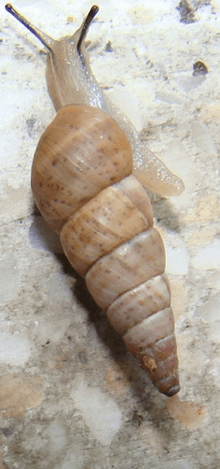Bostryx turritus
Bostryx turritus is a species of tropical air-breathing land snail, a pulmonate gastropod mollusk in the family Bulimulidae.
| Bostryx turritus | |
|---|---|
 | |
| Scientific classification | |
| Kingdom: | |
| Phylum: | |
| Class: | |
| (unranked): | clade Heterobranchia
clade Euthyneura clade Panpulmonata clade Eupulmonata clade Stylommatophora informal group Sigmurethra |
| Superfamily: | |
| Family: | |
| Genus: | |
| Species: | B. turritus |
| Binomial name | |
| Bostryx turritus | |
| Synonyms | |
|
Bulinus turritus Broderip in Broderip & Sowerby, 1832 | |
Distribution
This species was known from Trujillo Province in La Libertad Region (Pilsbry, 1896)[3] and Pariacoto in Ancash Region (Haas, 1955).[2][4] Recently, Ramírez (2004)[5] reported it from Cerro Pasamayo and Salinas de Huacho in Lima Region.[2] She also refers to unpublished data by Weyrauch, who collected the species at Cerro Campana, 14 km north of Trujillo 07°58’54’S 079°06’24’W (selected as type locality by Ramírez) and near Chilete in Cajamarca Region.[2] Breure (1978)[6] reported the species from the same department near Magdalena.[2] Breure (2010)[2] reported it from Catzcal 1050 m, 09°54’43’S 077°49’40’W, Ancash Region, Peru.[2]
Zilch (1953)[7] reports Bostryx turritus turritus (shell height/shell width = 3.25) from Hacienda El Casa Grande (probably near 07°40’S 078°40’W) in La Libertad Region, and described Bostryx turritus tamboensis (shell height/shell width = 2.87) from the same locality, albeit from different elevations (1500 m resp. 1000 m).[2] According to Haas (1955)[4] – reporting a locality at 1360 m – his shells ‘are slightly more slender than the typical form’.[2] The specimens from Catzcal show a variation in ration shell height/shell width from 2.84 to 3.18 (mean 3.00; n = 7).[2] It is possible that this variation can also be found in the populations at the localities in La Libertad, in which case Bostryx turritus tamboensis should be considered a synonym of the nominate taxon.[2]
Description
Living animal are whitish-grey throughout, the black eye-retractors are shining through the tentacles and the dorsal side of the body.[2]
References
This article incorporates CC-BY-3.0 text from the reference [2]
- Broderip W. J. & Sowerby G. B. (1832). "The collection of shells formed by Mr. Cuming on the western coast of South America and the South Pacific Ocean". Proceedings of the Zoological Society of London 1832: 104-108. page 106.
- Breure A. S. H. & Mogollón Avila V. (2010). "Well-known and little-known: miscellaneous notes on Peruvian Orthalicidae (Gastropoda, Stylommatophora)". Zoologische Mededelingen 84. HTM Archived 2018-09-26 at the Wayback Machine.
- Pilsbry H. A. (1895-1896). "American Bulimi and Bulimuli. Strophocheilus, Plekocheilus, Auris, Bulimulus. Manual of Cochology (2)10: 1-213.
- Haas F. (1955). "On non-marine shells from northeastern Brazil and Peru". Fieldiana Zoology 37: 303-337.
- Ramírez R. (2004). "Sistemática e filogeografia dos moluscos do ecosistema de ‘lomas’ do desierto da costa central do Peru". Unpublished PhD thesis: i-xxi, 1-165. PUCRS, Porto Alegre.
- Breure A. S. H. (1978). "Notes on and descriptions of Bulimulidae (Mollusca, Gastropoda)". Zoologische Verhandelingen Leiden 164: 1-255.
- Zilch A. (1953). "Landschnecken aus Peru". Archiv für Molluskenkunde 82: 49-61.